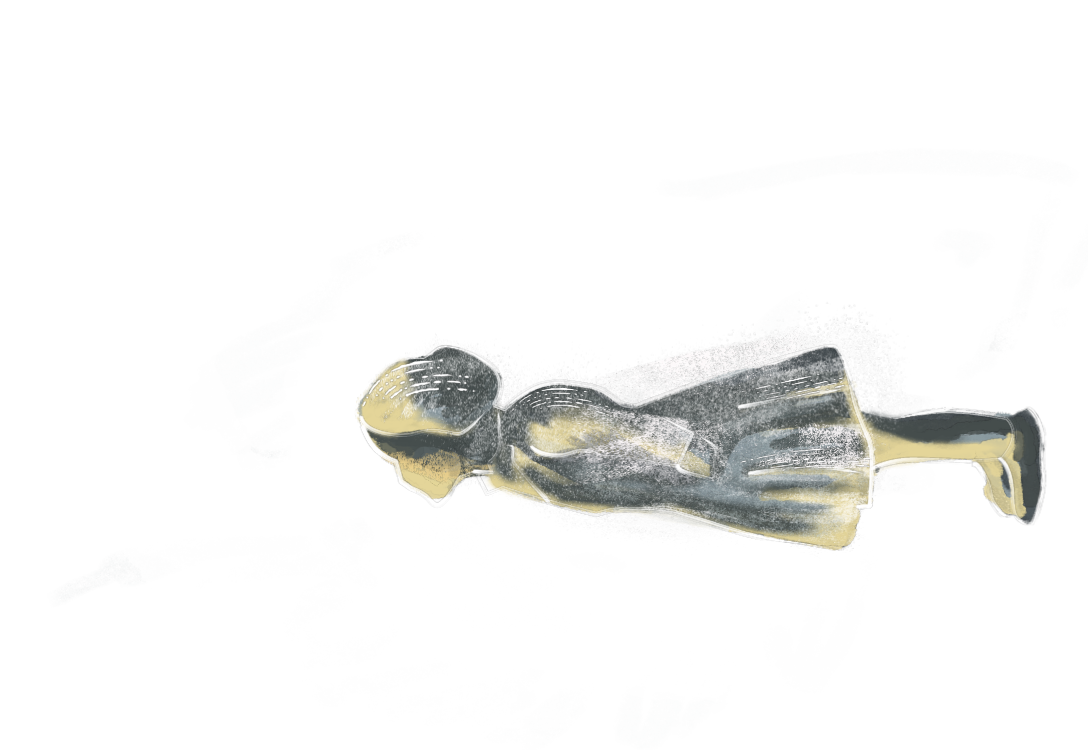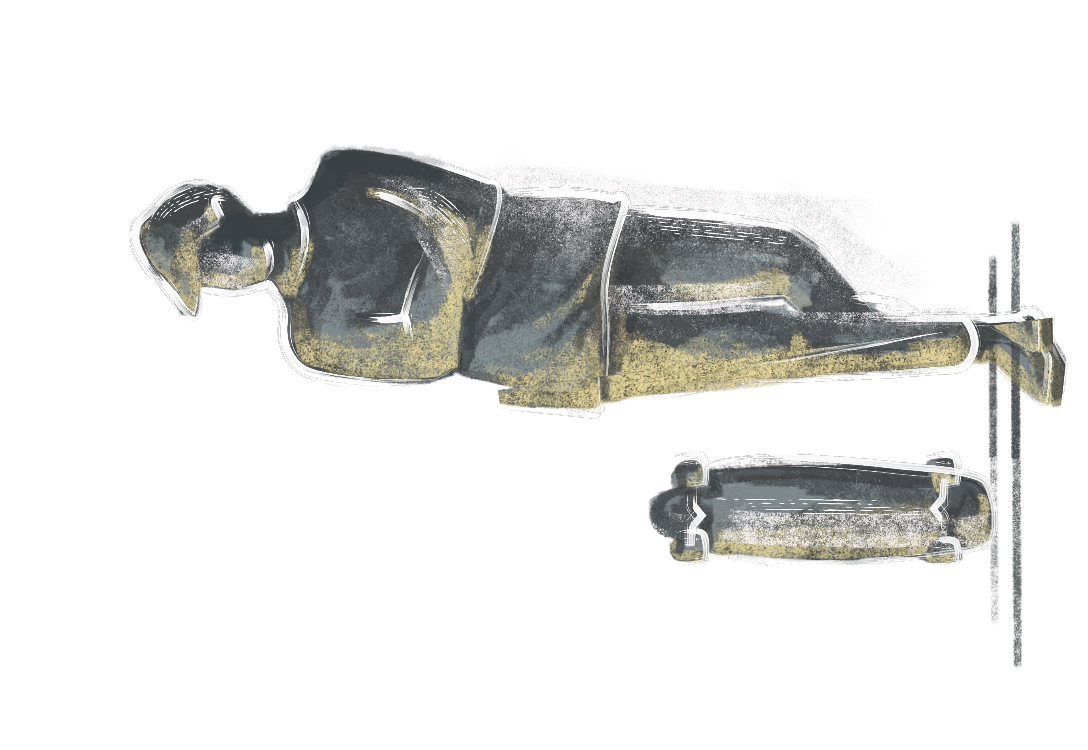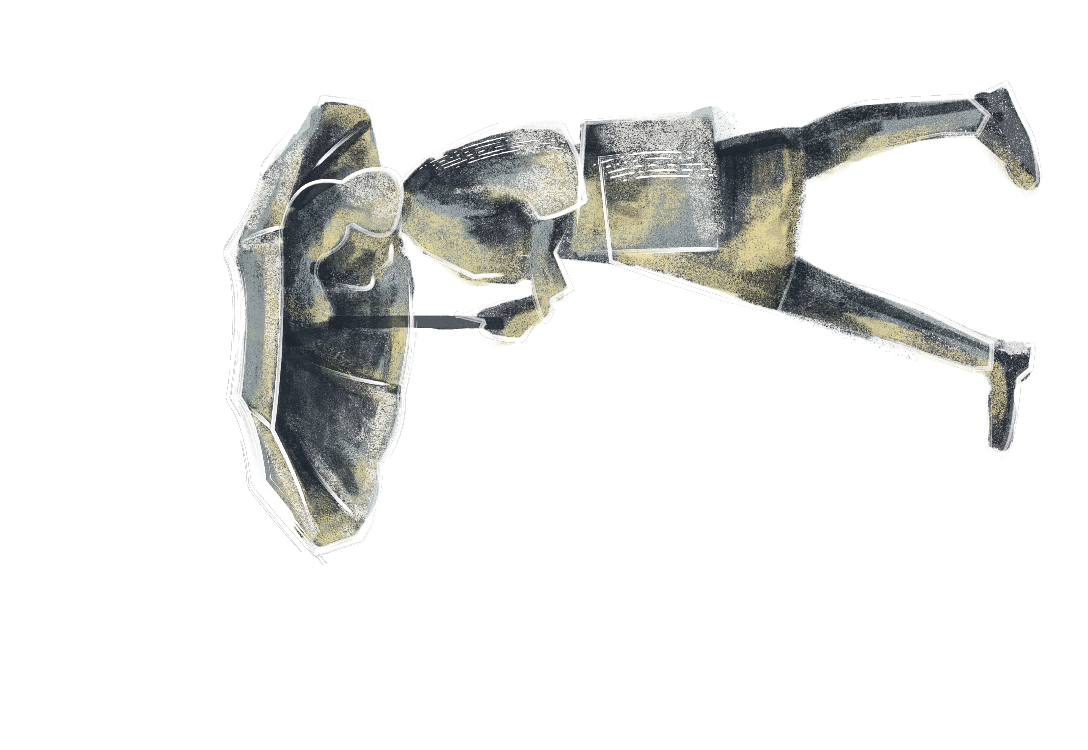

The SoulCraft Rebellion
Christopher Alterio, Rochester Institute of Technology
Maya used to be an occupational therapist – a title with little meaning amid the societal collapse following the Last Pandemic. Now she navigated the gray corridors of the Community Wellbeing Hub as a Human Optimization Engineer. She walked through those halls with seasoned efficiency and emotional detachment, despite three consecutive shifts with no sleep. She could sometimes hear the echoes of her prior purpose in the clicking of her heels on the unforgiving floors. She had once been dedicated to healing and fairness – grounded in pre-plague ideals about helping those society ignored. But the pandemic had left communities ravaged and resources scarce – 91 percent of humanity had perished before research created an end to viruses. The meaning of fairness had changed since she was young.
The Hub said they were “Elevating Humanity – One Strand at a Time.” They told her that she was still an occupational therapist, just one for a new age, with a new job title, but she knew that her reports now contributed to “resource allocation decisions.” In the wake of the Blame War, nuclear winter and failed harvests meant even the few people left went hungry. That reality felt bitter, but what choice did anyone even have? What was her original purpose? It was so hard to remember, and she was so tired.
Maya struggled each day with a troubling realization – just as the last virus infiltrated cells and decimated populations, it also infected and distorted the souls of the people who had survived. Now individuals were not valued for their inherent worth but were seen in the context of scarce resources. Perhaps they should have all seen this coming when the Hub began its first education campaign. They were told that they were “Improving Lives and Saving Money.” Those noble words took on a hollow meaning when disabled children were deemed “not people.” Somehow it became “selfish” to support those who could not contribute; the Hub proclaimed that they took up too many resources that other people needed. Even as years passed and things got better, the mindset persisted.
Maybe thinking about all of this just didn’t matter; she still had one more report to generate by the end of the day. Then she could sleep.
She adjusted the cold and sleek headband of her MindScribe, feeling that familiar tingle as it synced with the neural interface implanted in her temples. A hologram flickered to life in front of her, chasing the shadows from her workspace. She felt sick to her stomach as she reviewed the profile of the child she had just seen that morning.
She began composing her report, her thoughts converting seamlessly into text in the holographic display. The neural interface efficiently transcribed her clinical observations: delayed motor and self-care skills – and the distinct physical and developmental features of the child were auto-transcribed by the Hub databases and coldly identified as a likely genetic mutation, with an accompanying confidence rating of 97.8 percent. She knew what this would lead to, and a surge of conflicting guilt erupted in her mind.
Memories of her own nephew, the one her sister had been forced to send to the Vitality Renewal Initiative, overtook all her thinking. If the Hub didn’t catch and prevent any aberrant genetic expression before birth, then the VRI would eventually find them out. Once a child was sent there, no one ever saw them again. “Elevating Humanity – One Strand at a Time.” The mantra rang in her ears like the memory of her nephew’s cries as the Hub Administration took him away.
The efficient MindScribe, attuned to every neural impulse, captured her thoughts and betrayed her immediately as the revised hologram report appeared in front of her. “No!” she gasped, her voice trembling in both fear and horror. She watched as the MindScribe recorded her raw and unfiltered stream of consciousness – all her doubts about the morality of the Hub’s policies, and her longing for her nephew – all laid bare for everyone to see.
She reached for the manual interface with shaking hands, desperate to delete those rogue sentences before they could be saved into the permanent records. Her heart racing, she ripped off the MindScribe and hopelessly threw it at the hologram, hoping to break this mirror of her moral compromise. But the device flew straight through the words and had no effect. And the manual interface was locked. It was too late. Her thoughts were recorded.
Maya watched in horror as a stark new message appeared in front of her. “PLEASE REMAIN SEATED. A HUB ADMINISTRATOR WILL COME TO ESCORT YOU SHORTLY.” A cold wave of panic washed over her as she realized the gravity of her situation. She had already imagined this in her worst dreams – and she instinctively knew what she had to do. Run! Run! The internal directive roared in her ears; the muscles in her legs contracted, and she ran.
She escaped the Hub and ran for blocks, fueled by fear and adrenaline, with every footstep pounding out her defiance. Was she now free, or was she now condemned? Turning into the shadows of an alley, she saw these words scrawled into the weathered brick: “SoulCraft Awaits.”
She wondered – awaits for what?
The graffiti reminded her of rumors she had heard around the Hub. People whispered that SoulCraft was some kind of illegal collective that operated in secrecy – former medical healers who defied protocols and offered supports to those marginalized by Social Policy. The name “SoulCraft” represented deeper and more meaningful aspects of human experience and creativity that couldn’t be measured as ‘resources.’ The group worked to protect people with disabilities from the Hub’s unforgiving scrutiny. SoulCraft worked tirelessly to identify individuals before they were entered into the Hub’s databases by falsifying records, altering official genetic profiles, and sometimes even smuggling families outside of the Hub’s control. If caught, these SoulCrafters were disappeared or executed.
Maya sought refuge among this group of like-minded heretics. In an illicit digital speakeasy, she sought out unsanctioned /rumorNET conversations and sent private messages to users she hoped could help. Her working knowledge of the Hub’s inner systems convinced them that she was who she claimed to be, and the Hub’s online jackbots convinced them she was on the lam. She found Sanctuary.
+++



Maya hid in Sanctuary for weeks, her once long, brown hair now cropped short and dyed a stark black, a visible marker of her rebellion. Her new appearance was a necessity; being listed prominently on the Compliance Register meant she could no longer afford to be recognized. Each day in hiding, she wrestled with the weight of her past decisions and the precarious future she now faced.
Sanctuary was more than a physical refuge; it was a haven for the soul – hidden beneath layers of abandoned infrastructure in fallout shelters and subway tunnels. The Hub’s drones could never penetrate these spaces – old tech enthusiasts maintained jamming devices to disrupt neural interface scans.
Maybe this is what occupational therapy clinics used to be, she mused. Within its walls, former medical healers and social rebels gathered – waiting for better times or perhaps for hearts to change – but they had to operate in secrecy. The Hub’s surveillance wasn’t infallible, but it was omnipresent. Public spaces were panoptically monitored and even private thoughts were not completely safe, as she had so painfully and dangerously learned. The Hub dealt with anyone who contravened Social Policy with cold efficiency – just as they did with the children who disappeared into the VRI program. Sanctuary’s existence was a precarious balancing act – testament to the will and ingenuity of its participants.
In Sanctuary, Maya met other disillusioned and determined rebels. Among them was Dr. Dorothy Lucas, a former geneticist who fled the Hub after discovering the Vitality Renewal Initiative’s true purpose. She was a leader within the SoulCraft collective, guiding their efforts with both compassion and strategy.
To mislead the Hub’s MindScribe detectors, Dorothy’s tech team created a synthetic neural signature to make it appear as though members were still in their registered locations, allowing them to meet and plan their initiatives in secrecy. One evening Dorothy addressed them with unwavering conviction and announced, “We can’t hide forever. The Hub’s reach is growing, and more people are at risk. We must act.”
Maya felt a surge of purpose, or perhaps an opportunity for redemption, asking “But what can we possibly do?”
Dorothy smiled with shared determination. “We’ve identified flaws in the Hub’s genetic screening algorithm. We can access their mainframe and expose the truth to show everyone in the region what is happening.”
Maya volunteered for the mission immediately, largely to erase the guilt that she felt for her prior complicity. Years of work helped her know the Hub’s systems well. The team planned carefully for the infiltration to avoid detection, or worse.
On the night of the operation, Maya’s heart pounded out both fear and anticipation. Equipped with the necessary tools, Maya, Dorothy, and a small team made their way to the Hub after dark. The Hub’s panoptic surveillance cameras were temporarily disabled by one of their tech experts, giving the group a narrow window for action.
Inside the Hub, Maya’s sense of oppression escalated as she led the team to the mainframe room. Her knowledge of the layout and security protocols guided them past many obstacles. When they finally reached the room, Maya quickly got to work, her fingers flying over the terminal.
Minutes felt like hours as she manually navigated through layers of encryption. Finally, she found the genetic screening algorithm. With a deep breath, she uploaded the data that would expose the Hub’s true purpose. The system gave no confirmation, no neat progress indicator – all she could see was the faint, stuttering flicker of the terminal screen. Like a whisper through a locked door – the same way she participated in
/rumorNET – she knew that her task was completed.
Suddenly, the door burst open, and Hub security guards stormed in. “STOP!” one of them screamed, weapons drawn. It was too late. The task was done. The data was already in the network.
The guards moved closer – their intentions clear. In the chaos, Maya caught a final glimpse of the terminal screen – a blinking cursor and then a system breach alert. The truth was now out there, broadcast to every connected device in the country.
Maya saw the guards overpower Dr. Lucas, dragging her to the ground and killing her, but the damage was done. The Hub’s secrets were exposed, and the public would know the truth about the genetic screenings and the Vitality Renewal Initiative.
The remaining team tried to escape, but running didn’t matter, even if they didn’t have time to realize this. Time and space instantly became irrelevant. In real terms they were incinerated immediately by laser blast, but that moment in time stretched out infinitely. Every horror that had driven their purpose merged into a single event horizon. In the end, Maya felt like she was drowning and melting into the Earth in front of her, hearing that horrible whir-chop of Hub helicopter blades as she ran, dying in a moment that lasted an eternity. Her final thoughts were coldly processed through her neural link – blurred images of her sister’s tears, of all the children she failed to save, and then a surprised realization of her own end – and that it might spark a change that she would not live to see.
Dorothy had planned for this contingency – and had a covert protocol embedded in the team’s neural interfaces. This ensured that the team’s final thoughts – raw and unfiltered – were also captured, transcribed, and transmitted in profoundly human detail across the network. News of the Hub’s practices spread rapidly, igniting outrage and protests. People demanded change, and the Hub’s authority began to crumble under the weight of public scrutiny – at a terrible cost. The collective outrage was called ‘The SoulCraft Rebellion,’ and although it brought some change, it was very slow and painful. The Hub’s grip tightened before it loosened, and many people were crushed in the struggle.
The rebellion had only just begun. Sanctuary grew from a whisper to a network and a collective symbol of defiance. “SoulCraft Awaits” wasn’t only a call to arms; it was a desperate cry for survival in a system that had lost sight of its ethics and purpose. Maya’s name, though erased from the Compliance Register, became a rallying cry for a generation determined to reclaim their humanity.
In the years that followed, Maya’s name faded and became legend, but SoulCraft moved from rebellion to philosophy. It reminded people that humanity’s worth could never be reduced to a resource calculation, no matter how broken the world became. SoulCraft became the foundation for a new era, even if it had to be built differently, but still one strand at a time.
